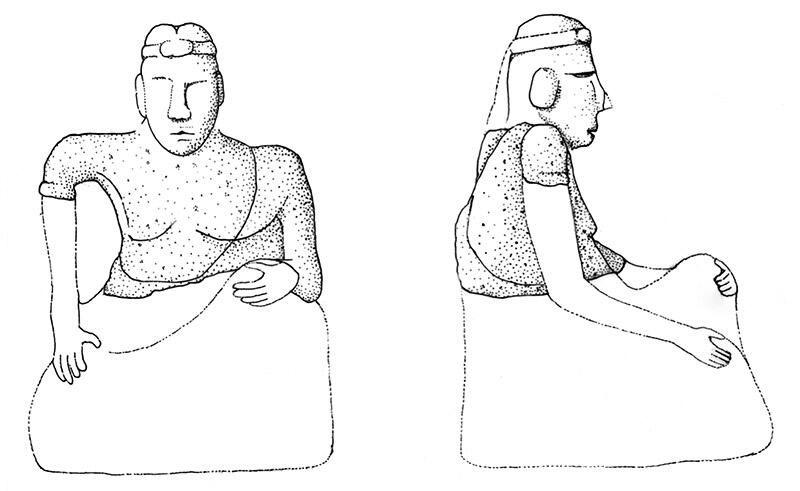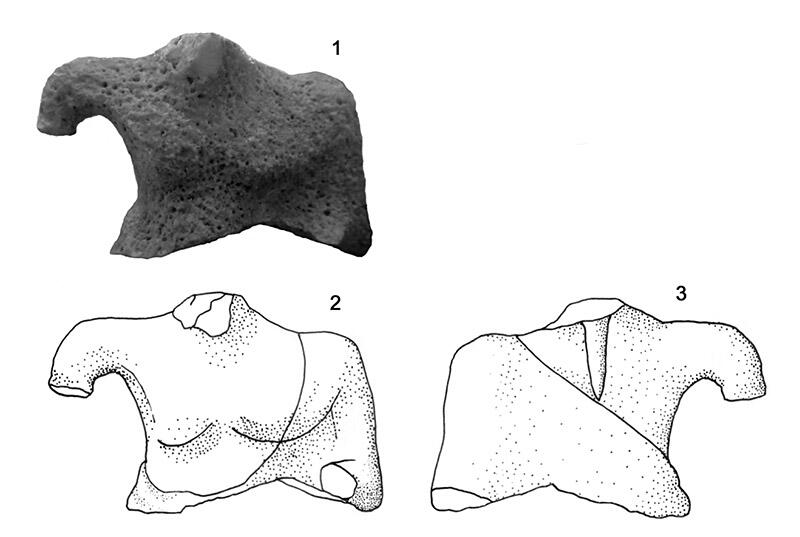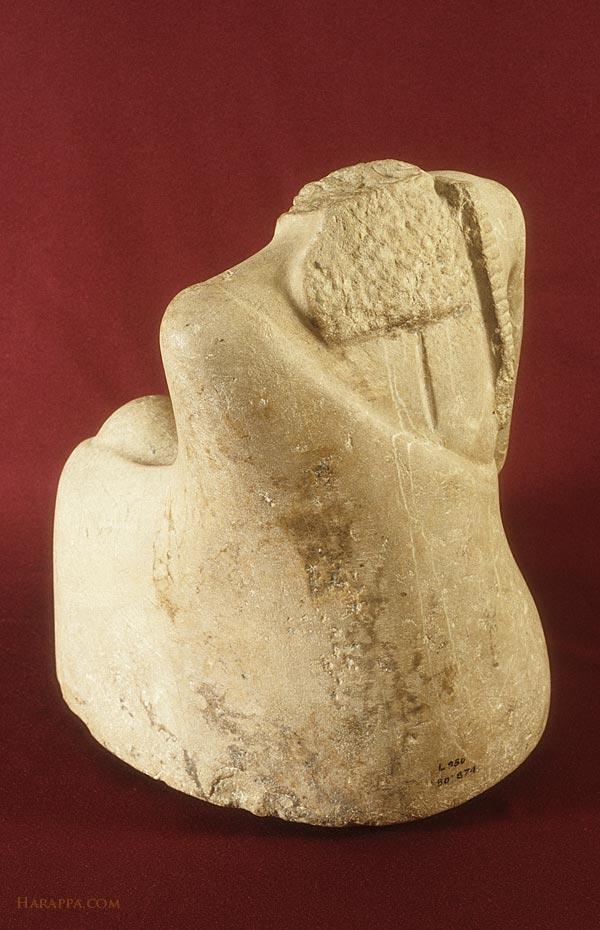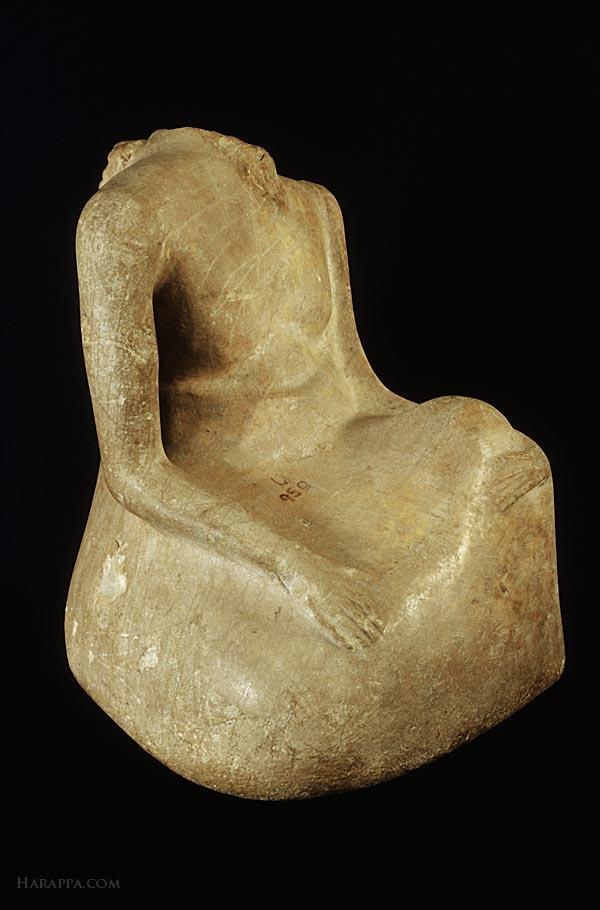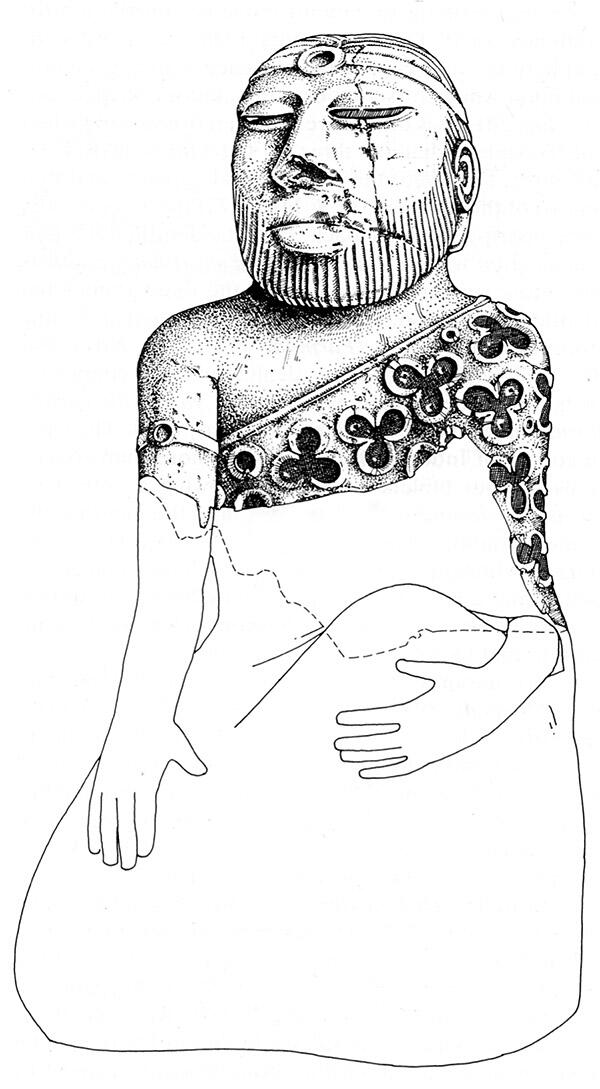"A small showcase of the Zahedan Museum keeps, among other finds, the fragmentary headless torso of a small statuette in a buff-grey limestone, with a strongly weathered surface. Without opening the showcase, I was allowed to take several pictures of the fragment, from various angles. One of the pictures was taken frontally, from a close proximity. Other pictures were taken from rear and from a side but with less satisfactory results. Fig. 1 [Image 2] illustrates the picture taken from the showcase, plus two drawings based upon this record and the author's personal scrutiny of the piece. Its residual height wavers between 10 and 12 cm" writes Massimo Vidale. He reconstructs this torso with surprising similarities to a headless torso found at Mohenjo-daro [Images 3 and 4], and a head at Mundigak, and then redraws it with another"head found on the surface of Tepe Chah-i Torogh," also a Kandahar-Helmand culture find in Afghanistan. "In this new light, the Zahedan torso confirms that the same sculptural model had a widespread distribution, which is encountered in a single leg and lap fragment at Gonur Depe on the Murghab delta in Margiana, in the head found at Mundigak on the Arghandab river in Kandahar, Afghanistan, in other heads from sites of the Seistan basin, as well as in various states of conservation at least two major sites of the greater Indus valley such as Mohenjo-Daro (12 specimens) and Dholavira (one fragment; for references see below) . . .. After Mohenjo-Daro, Shahr-i Sokhta and its hinterland is where this sculptural model is most consistently attested" (pp. 1-6).
What could this suggest? Vidale proceeds to show how this model likely date to a later period of all these cultures, around 2000 BCE, and writes: "Kenoyer remarks that, beyond Central Asian affiliations, the closest match for the Mohenjo-Daro series is with the Kandahar-Helmand group. Kenoyer believes, in short, that people bound by a specific ideology, or even immigrants from other parts of Middle and/or South Asia, including Seistan, were living in Mohenjo-Daro keeping with them their statuettes," a conjecture his discussion supports. He notes, for example, that the "priest-king" statue found at Mohenjo-daro is quite unlike other specimens from the site, giving it a possibly foreign origin, which he extends to later figures from the Bactria/Margiana region, "the workshops of the Oxus Civilization" north of Afghanistan (p. 9).
The speculative conclusion is very unsettling given how much this figure has been taken to represent the Indus civilization: "However, we known too little to state with confidence whether the damaged Mohenjo-Daro stone statuettes, together with the misnamed "Priest King", should be eventually labelled "Bactrian" or "Harappan", or something else; but the general use of the Mohenjo-Daro "Priest-King" as a symbolic icon of the Indus Civilization is probably inappropriate. In their stylistic heterogeneity, the statuettes of the Mohenjo-Daro series, as argued by Kenoyer, might have belonged to a minority group of the urban population, and possibly might have been made in different centers and regions outside the Indus core area" (p. 10).
An extremely interesting and thought-provoking paper that points to how much we do not know about ancient Indus culture, and how, in the absence of information, we privilege visuals and form conceptions that may be wrong. It also points to links between Indus people with cultures and people to the northwest, and the great mobility of certain motifs across large areas. As usual, Massimo Vidale is not hesitant to bring new and exciting discoveries to bear on profound questions.
This paper goes well together with Stone Sculptures from the Protohistoric Helmand Civilization, Afghanistan by George F. Dales.
Images: 1. Conjectural graphic reconstruction of the likely original setting of the Zahedan torso as a "Priest King", based upon the head from Chah-i Torogh 2 (Seistan, Iran) visible in Fig, 3, and the general form and proportion of statuette L 950 (Fig. 4). The side view is less certain than the front and the rear ones (drawing M. Vidale).
2. A frontal picture of the Zahedan torso. 2 and 3: graphic enhacements of the front and rear of the same fragment based upon 1.1 (picture and drawings by M. Vidale).
3. Seated male figure with head missing from Mohenjo-daro (back).
4. Seated male figure with head missing from Mohenjo-daro (front).
5. The steatite "Priest-King" of Mohenjo-Daro as reconstructed in Ardeleanu-Jansen (1984).

